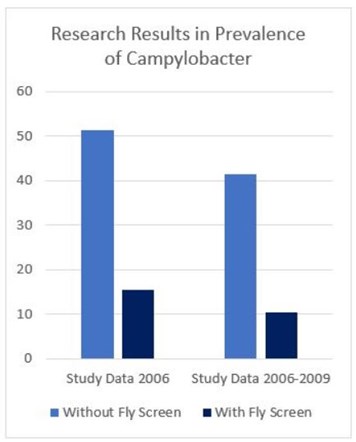Fly screen reduces
the risk of Campylobacter prevalence
SKOV is now launching a new fly screen that reduces the risk of Campylobacter which is one of the most common bacterial causes of human gastroenteritis in the world. The main route of transmission is via meat products, as well as raw or contaminated milk. However, consumption of undercooked poultry meat is believed to be the primary source of infection, and for that reason, the elimination of Campylobacter from broilers is a high priority in poultry production.
In the fight against Campylobacter, poultry productions all over the world have continuously improved hygienic practices to protect the farms from bacteria. In most cases, these initiatives have had a positive impact on the outbreaks during the winter months. However, even strict compliance with all biosecurity regulations has failed to reduce infections to the same level as in winter, implying that the transmission routes of Campylobacter remain to be fully elucidated.
Fly screens proved to reduce Campylobacter in broiler houses
The seasonal variation in outbreaks of Campylobacter has induced researchers to examine the vectorial potential of flies in the transmission of the bacteria, as the seasonality of infections in humans and broilers is consistent with the abundance of flies in the same seasonal period. To test the hypothesis that the influx of flies increases the transmission of Campylobacter to broilers, a group of researchers from the National Veterinary Institute of Denmark mounted fly screens on twenty broiler houses in Denmark during the summer of 2006. The outcome revealed that preventing flies from entering broiler houses caused a significant drop in campylobacter-positive broilers from 51.4% to 15.4%*. However, these results cover only one summer and only one season of the year. Thus, to provide more long-term results, a new group of researchers has subsequently decided to examine the year-round effects of fly screens in poultry houses by conducting an examination based on a 4-year data set. The results from this research were consistent with the results obtained in 2006, as it revealed that the number of Campylobacter-positive broilers was reduced from 41.4% to 10.3%*.

However, these results cover only one summer and only one season of the year. Thus, to provide more long-term results, a new group of researchers has subsequently decided to examine the year-round effects of fly screens in poultry houses by conducting an examination based on a 4-year data set. The results from this research were consistent with the results obtained in 2006, as it revealed that the number of Campylobacter-positive broilers was reduced from 41.4% to 10.3%*.
SKOV's new DA 1200 fly screen
As research showed that fly screens have a substantial reduction effect on the incidence of Campylobacter among broilers, a significant measure to existing biosecurity could be to integrate more fly screens in the construction of poultry houses. It is the purpose of SKOV’s new DA 1200 fly screen, as it is designed to cover the wall inlets in the livestock house so that the air intake through the wall inlets would have to pass the fly screen and thus prevents potentially infected flies from entering the house.
As proven by research, the use of fly screens is an easy and effective way to reduce the number of flies entering the houses and reduce the potential cases of Campylobacter infections among broilers and humans around the world. However, several factors could limit the adoption of the method such as the difficulty of installing and servicing the fly screens. SKOV’s new DA 1200 fly screen meets these concerns, as it is a standardized solution facilitating both mounting and cleaning of the screens. You can also retrofit the DA 1200 fly screen on wall inlets in existing livestock houses, as it is a universal solution for mounting around all wall inlets that match the measurements of the fly screen. In overall terms, SKOV’s DA 1200 fly screen demonstrates how a simple solution can make a huge difference in the attempt to avoid diseases that pose a threat to the poultry industry and the safety of the human food supply.
The DA 1200 fly screen was released for sale at the end of November 2018.